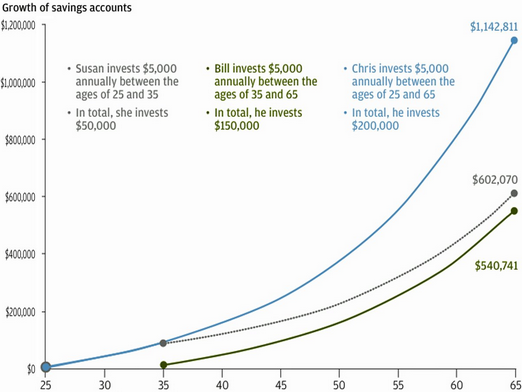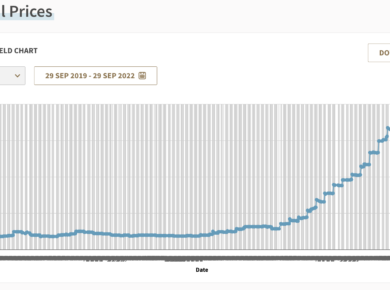Ever since my article went viral, some readers have also written in to share about how their peers laugh at them when they are trying to save, and how sometimes it affects their social life. Some are strong enough to withstand the pressure, whereas others end up caving in sometimes. If you are in this situation, remember, other people may laugh at you now, but you’ll be the one laughing in the future when you are cash-rich and your peers regret their spending choices (albeit too late).
When we graduate and get our first pay-check, for most of us, our spending tends to increase as well.
Have you heard of the classic dilemma in the diagram above? Well, as a young working adult in my 20s now, I’m at a stage of life where I have (more) money, still in relatively good health, but have lesser time (compared to when I was a student).
Comparing a monthly $500 scholarship allowance to a $2000 disposable income (after CPF deductions), suddenly I feel rich and able to buy all the things I wasn’t able to before. Branded bags, facial and slimming packages, etc, all start to come into the picture. As a child, I didn’t get to travel much, so I start buying trips overseas as well.
That’s what most of our peers today do. And that’s what people who laugh at us for saving now, are guilty of. It’s ok, look at this:
Chris is a smart guy like you and me, who starts saving early with $5,000 every year. With compound interest of about 7% per annum, he puts in $200K over 40 years, but walks away with over $1 million. That’s more than 5 times, which means Chris earned $800K – or an average of $1,667 a month just by starting to save early.
Bill represents the people who laugh at us now for spending, and his attitude is “You should YOLO! Why be so hard on yourself? Must enjoy life or you will regret it!”. He becomes wiser when he reaches 35 and decided that he should learn from his buddy Chris, and start saving $5,000 like him. As he started 10 years later, he puts in a total of $150K, and walks away with over $600K. He lost out on $400K compared to Chris. That’s the price of his lesson.
Who’s laughing now?
This morning my friend also shared with me a pretty good article about the differences between middle-class and rich people, which has inspired me to adapt and add on specifically for Singapore’s context.
Note: The “rich” below refers mainly to self-made riches, rather than those lucky enough to have been born into rich families.
Habit #1: The middle class live above their means, the rich live below
The middle class have bad management in controlling their purse strings. They are your typical consumer, who spends without thinking, buys into the latest advertising gimmicks and trends, and doesn’t really bother about calculating their spending or setting a budget.
The rich, on the other hand, does not really care for all these luxuries. Instead of always eating out at restaurants or buying the latest branded bag, you’ll find them eating at food courts and carrying just that one branded bag they bought and stuck with ever since.
The middle class are friends with everyone, the rich choose their friends wisely
It is fine to be friends with high maintenance people, but if you find yourself spending too much when you’re out with them, maybe you should cut down on meeting them, or even cut them out of your life.
I have a friend who loves going to cafes. Every time I meet her, we end up eating at some exotic cafe place with bills that run up to a total of $60 – $100. It has been over 3 months since I last hung out with her, and boy, has my savings increased.
Also, as you grow older, one thing I’ve discovered is that it isn’t about the number of friends you have, but rather, the quality of the friends you own. One guy I know saves like crazy, but puts aside $50 each month to give a treat to a co-worker or important client. Little connections like that can bring you a long way into the future.
Habit #2: The middle class work to earn, the rich work to learn
This describes most of the Gen Y and Z population. We lament about the low starting pay, and immediately expect a $3000+ salary once we sign onto a full-time job. We want a 9 – 5pm role, complain about working overtime, and then complain again when we are passed over for promotions or a pay raise.
Just because you are a degree-holder, doesn’t mean the company is obliged to pay you $3000. Take a step back and as you examine your own expectations, question yourself if that is that the value of the work you can give them?
A number of my university friends started with $3000+ salaries. I was offered $2,500 in my first full-time job, but I took it anyway, because I knew I would be able to learn some valuable skills from it. After that, I switched from a higher-paying job to the one I am in now, because I recognized the opportunities and growth prospects that the new role offered me. And while my bank account has less money coming in every month, I am learning and growing a lot more. These skills will be useful to me if I ever leave this job, and is a lesson that money cannot buy.
Short-term losses for long-term gains.
Habit 3: The middle class are possessions-rich, the rich are cash assets-rich
Middle class people tend to be influenced by their peers and society. They want others to think well of them, thus they splurge on the latest trends. They proudly show off their newest LV bag, acting humble when people comment on it.
The rich people normally can’t care less. In fact, they keep a lower profile and rather not have people notice them too much. They are also smart enough to know that spending your money on depreciating assets like branded bags, a new car, and a new home, is a choice that makes you feel good for now, but one that you will regret later. The graph below (shared with me by one of my readers, Lim Pei), illustrates this really well:
Habit #4: The middle class spends less on insurance than the rich
The middle class doesn’t quite understand the value, and importance, of insurance. They only see it as a liability, a fixed cost which they have to keep paying every month with “no returns”. The rich, however, understands how critical it is to be sufficiently covered, lest they lose their lifetime savings to a critical illness or hospital bill that comes suddenly without warning. Medical bills are one of the top few reasons why Singaporeans go into debt, but the rich already know this, and have already prepared themselves against it.
Habit #5: The middle class spends money in the now, the rich saves money now for it to grow over time
If you have any other ideas or differences to contribute, please share with me in the comments below!
With love,
Budget Babe
Originally inspired, and partially adapted from http://www.lifehack.org/articles/money/10-differences-between-middle-class-and-rich-people.html













8 comments
JFREE: Of all his books, I only think of his concept of "asset= bring in money, liability= spending money". the rest are not as interesting as the other investment books out there.
BB: Yea, hope you start your investing journey soon. Having large amount in the bank is just wasting their potential, not to mention you are losing out quite a lot with the low interest rate and high inflation.
Looking forward
look forward for you to start building your assets instead of saving that money inside your bank!
Very smart! I actually counted assets as "cash" since it's basically just cash tied up in cash-generating assets, but you're right that the clarification ought to be clearer, so I've added that in 🙂
wow seems like everyone is a fan of Robert Kiyosaki!
Hi Budget Babe,
I think you made some typo..
Chris is a smart man like you and me, who starts saving early with $5,000 every year. With compound interest of about 7% per annum, he puts in $200K over 40 years, but walks away with over $1 million. That's more than 5 times, which means Chris earned $800K – or an average of $1,667 a month just by starting to save early.
Bill represents the people who laugh at us now for spending, and his attitude is "You should YOLO! Why be so hard on yourself? Must enjoy life or you will regret it!". He becomes wiser when he reaches 35 and decided that he should learn from Chris, and start saving $5,000 like her. As he started 10 years later, he puts in a total of $150K, and walks away with over $600K. He lost out on $400K compared to Chris. That's the price of his lesson.
Hi Kenogi, I've just gotten Facebook! Do add me at Budget Babe 🙂
Hi Kenogi, I've just gotten Facebook! Do add me at Budget Babe 🙂
If you want to find serious millionaire dating, you can google "millionaire dating" or "rich men dating", like "millionairematch.com" is on the first result.
Comments are closed.